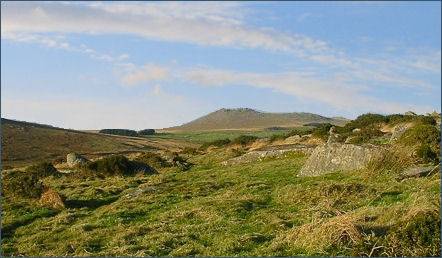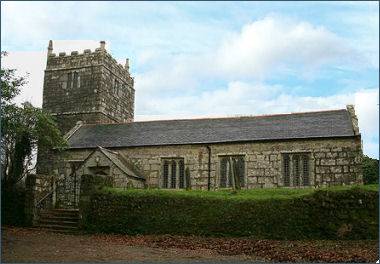Warleggan
OS Grid ref:- SX 1569
 The hamlet of Warleggan is situated on the southern edge of Bodmin Moor and lies five and a half miles to the east of the town of Bodmin. The name is thought to derive from the Cornish Worlegan meaning a high place.
The hamlet of Warleggan is situated on the southern edge of Bodmin Moor and lies five and a half miles to the east of the town of Bodmin. The name is thought to derive from the Cornish Worlegan meaning a high place.
Until a road was built in 1953 linking it to the A38 it was known as the most remote village in Cornwall. Mainly a cattle farming region, Warleggan consists of about fifteen houses, a church and a chapel.
The village is known in the Cornish language as Gorlegan. The River Warleggan, a tributary of the River Fowey, runs through the parish, forming its western boundary in places.
 The village church is dedicated to St Bartholomew and is partly Norman and partly fifteenth century in date. In the North Wall
is a blocked fourteenth century doorway. The North door was known as the devils door as it was by this door the devil was believed to be driven at a baptism. The elvan font dates from the fifteenth century.
The village church is dedicated to St Bartholomew and is partly Norman and partly fifteenth century in date. In the North Wall
is a blocked fourteenth century doorway. The North door was known as the devils door as it was by this door the devil was believed to be driven at a baptism. The elvan font dates from the fifteenth century.
St Bartholomew's was one of the few churches on the moor to possess a spire but this was struck by lightning and fell in 1818 after which it was not rebuilt. The interior of the church was restored in the nineteenth century. The granite cross in the churchyard is said to have been moved in the nineteenth century from near Carburrow where it was thought to of been used to mark the path across the moor from Warleggan to Temple.
 From 1931 until his death the Rev Frederick William Densham was Rector of Warleggan. He began his ministry at the isolated parish by painting the church's interior with bright murals, banning concerts and whist drives, consorting with chapel folk, and preaching vegetarianism in a parish of farmers.
Describing organ music as a "gabbled profanity", he threatened to get rid of the church organ, at which outspoken farmer and churchwarden Nick Bunt responded by warning him: "If you touch that organ, vicar, I'll knock ee down."
From 1931 until his death the Rev Frederick William Densham was Rector of Warleggan. He began his ministry at the isolated parish by painting the church's interior with bright murals, banning concerts and whist drives, consorting with chapel folk, and preaching vegetarianism in a parish of farmers.
Describing organ music as a "gabbled profanity", he threatened to get rid of the church organ, at which outspoken farmer and churchwarden Nick Bunt responded by warning him: "If you touch that organ, vicar, I'll knock ee down."
The rather unworldly Rev. Densham's eccentric ways and unorthodox manner led to a the villagers petitioning Dr Walter Frere, the Bishop of Truro to remove him, when this failed he was boycotted by his parishioners, and eventually he preached to an empty church. Densham sang the hymns alone, composed new sermons each week and placed small cards on pews bearing the names of his predecessors going back hundreds of years. This action was perhaps the source of the story that he preached to cardboard cutouts. He decorated the rooms of the rectory with scenes from the Bible lands and erected a barbed wire fence around the grounds to keep out unwanted visitors. Densham remained in the parish and lived the life of a recluse until in 1953 he was found dead on the staircase in his barricaded rectory at the age of 83. The rectory is purported to be haunted. The author Daphne du Maurier based a novel on Densham’s story.
Cabilla Manor Wood, an area of broadleaved, mixed and yew woodland in the west of the parish, is a Site of Special Scientific Interest (SSSI) noted for its biological interest. The SSSI surrounds the River Warleggan, extending into Cardinham.